

Anatomía / anatomy for artists. Bien manger.
A Map of the Whole Genome Tracks Outbreaks. During April and May this year, 14 people in the United States were infected by an outbreak of food-borne E. coli.

One of them died, and public health officials are still hunting for the source of the outbreak. Such detective work normally involves using a decades-old DNA fingerprinting technique to identify and trace the strains of microbes responsible. But a technology for whole-genome analysis of microbes could lead to quicker identification and more comprehensive analysis. More broadly, the technique could help researchers better understand the structure of genomes—disease-related or not—and the order of genes within. Human Microbiome Project DACC - Home.
Professional association. A professional association (also called a professional body, professional organization, or professional society) is usually a nonprofit organization seeking to further a particular profession, the interests of individuals engaged in that profession, and the public interest.
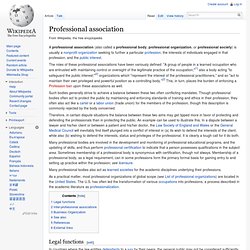
The roles of these professional associations have been variously defined: "A group of people in a learned occupation who are entrusted with maintaining control or oversight of the legitimate practice of the occupation;"[1] also a body acting "to safeguard the public interest;"[2] organizations which "represent the interest of the professional practitioners," and so "act to maintain their own privileged and powerful position as a controlling body.
"[2] This, in turn, places the burden of enforcing a Profession ban upon these associations as well. Such bodies generally strive to achieve a balance between these two often conflicting mandates. Legal functions[edit] Asociación Chilena de Informática en Salud. IMIA. AMIA. Mobile computing. The Galaxy Nexus, capable of web browsing, e-mail access, video playback, document editing, image editing, among many other tasks common on smartphones.
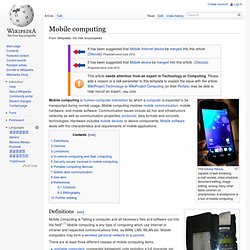
A smartphone is a tool of mobile computing. Mobile computing is human–computer interaction by which a computer is expected to be transported during normal usage. Mobile computing involves mobile communication, mobile hardware, and mobile software. Communication issues include ad hoc and infrastructure networks as well as communication properties, protocols, data formats and concrete technologies. Hardware includes mobile devices or device components. Definitions[edit] Mobile Computing is "taking a computer and all necessary files and software out into the field".[1] Mobile computing is any type of computing which use Internet or intranet and respective communications links, as WAN, LAN, WLAN etc. iPad in Healthcare: Quantitative Assessment and Qualitative Analysis. PRLog (Press Release) - Aug. 25, 2010 - In this report we analyze iPad in the marketplace including the threat of direct and indirect competition by applying Porter's 5-forced model.
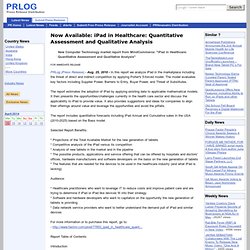
The model evaluates key factors including Supplier Power, Barriers to Entry, Buyer Power, and Threat of Substitutes. The report estimates the adoption of iPad by applying existing data to applicable mathematical models. OpenSource HIT. Int Org for Standardization. TC 215 - Health informatics. Privilege mgmt & access control - Policy. Requirements for an electronic health record architecture.
Clinical data warehouse - best practices. Health indicators framework. EHR definition. Reqts for EHR architecture. Academic journals. An academic journal is a peer-reviewed periodical in which scholarship relating to a particular academic discipline is published.
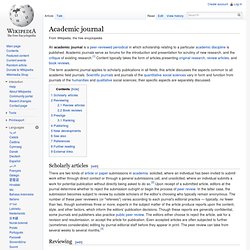
Academic journals serve as forums for the introduction and presentation for scrutiny of new research, and the critique of existing research.[1] Content typically takes the form of articles presenting original research, review articles, and book reviews. The term academic journal applies to scholarly publications in all fields; this article discusses the aspects common to all academic field journals. Scientific journals and journals of the quantitative social sciences vary in form and function from journals of the humanities and qualitative social sciences; their specific aspects are separately discussed. Scholarly articles[edit] Reviewing[edit] Review articles[edit] Review articles, also called "reviews of progress," are checks on the research published in journals. Health Informatics Journals. Graduate school. A graduate school is a school that awards advanced academic degrees (i.e. master's and doctoral degrees) with the general requirement that students must have earned a previous undergraduate (bachelor's) degree.[1][2] A distinction is typically made between graduate schools (where courses of study do not provide training for a particular profession) and professional schools, which offer specialized advanced degrees in professional fields such as medicine, business, engineering, ministry or law.
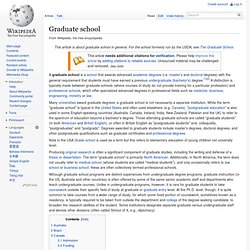
Many universities award graduate degrees; a graduate school is not necessarily a separate institution. While the term "graduate school" is typical in the United States and often used elsewhere (e.g. Canada), "postgraduate education" is also used in some English-speaking countries (Australia, Canada, Ireland, India, New Zealand, Pakistan and the UK) to refer to the spectrum of education beyond a bachelor's degree. Colombia. Colombia (/kəˈlʌmbiə/ kə-LUM-biə, or /kəˈlɒmbiə/ kə-LOM-biə), officially the Republic of Colombia (Spanish: República de Colombia [reˈpuβlika ðe koˈlombja]), is a country on the northwestern coast of South America, bordered to the northwest by Panama; to the north by the Caribbean Sea; to the east by Venezuela[11] and Brazil;[12] to the south by Ecuador and Peru;[13] and to the west by the Pacific Ocean.

It is a unitary, constitutional republic comprising thirty-two departments. The territory of what is now Colombia was originally inhabited by indigenous peoples including the Muisca, Quimbaya, and Tairona. The Spanish arrived in 1499 and initiated a period of conquest and colonization ultimately creating the Viceroyalty of New Granada, with its capital at Bogotá.[14] Independence from Spain was won in 1819, but by 1830 "Gran Colombia" had collapsed with the secession of Venezuela and Ecuador.
What is now Colombia and Panama emerged as the Republic of New Granada. Etymology History. Universidad de Antioquia - Maestría en Ciencias Básicas Biomédica - Enfasis en Informática Médica. United States. The United States of America (USA), commonly referred to as the United States (US), America or simply the States, is a federal republic[10][11] consisting of 50 states and a federal district. The 48 contiguous states and the federal district of Washington, D.C., are in central North America between Canada and Mexico.
The state of Alaska is the northwestern part of North America and the state of Hawaii is an archipelago in the mid-Pacific. The country also has five populated and nine unpopulated territories in the Pacific and the Caribbean. At 3.79 million square miles (9.83 million km2) in total and with around 317 million people, the United States is the fourth-largest country by total area and third largest by population. Biomedical Informatics. MyDBMI. eLearning - HI Courses at RCSEd. Global health informatics. Transcending Borders - Conf Apr 2012. WHO - health tech for low-resource settings. Global Health Informatics Partnership. Leveraging ICT for the Base Of the Pyramid.
MIT - Innovations in International Health. GHSintiatives. Global Health Council. PATH: A catalyst for global health. Global Health Delivery. Advancing global health through informatics. Public release date: 9-Feb-2012 [ Print | E-mail Share ] [ Close Window ] Contact: Kim Coghillcommunications@amia.org 301-657-1291American Medical Informatics Association BETHESDA, Md., Feb. 9, 2012 -- Informatics leaders, practitioners and other members of the healthcare community will convene June 23-27, 2012, in Montreal, Canada, for the 11th International Congress on Nursing Informatics (NI2012).

The Congress gives participants from across the world a forum to discuss the impact of informatics on patient care improvement, global health, professional practice, health policy and research. Ontology (information science) In computer science and information science, an ontology formally represents knowledge as a hierarchy of concepts within a domain, using a shared vocabulary to denote the types, properties and interrelationships of those concepts.[1][2] Ontologies are the structural frameworks for organizing information and are used in artificial intelligence, the Semantic Web, systems engineering, software engineering, biomedical informatics, library science, enterprise bookmarking, and information architecture as a form of knowledge representation about the world or some part of it.
Snomed-CT. SNOMED Clinical Terms - Summary. SNOMED CT has been created by combining SNOMED RT and a computer-based nomenclature and classification known as Read Codes Version 3, which was created on behalf of the U.K.
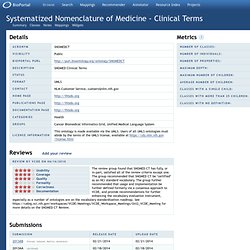
Department of Health and is a Crown copyright. SNOMED CT Concept (SNOMED RT+CTV3) SNOMED CT January 2005 Release: 20050131 [R] SNOMED CT January 2003 Release: 20030131 [R] SNOMED Clinical Terms version: 20090731 [R] (July 2009 Release) Maternal and neonatal health - Buscar con Google. Innovation Index. Global Health Delivery Online: Improving health care delivery through global collaboration. Hi All, I volunteer with a clinic in rural India and we have had issues in providing continuity of care to the patients that we see.

Our current medical record system consists of a paper card that the patients are instructed to bring with them when they come back for further care. This works reasonably well when they remember to bring the card with them, but we have many individuals who chronically forget. I have played with the idea of using an EMR like OpenMRS to help us solve this problem, but we are also in an area where addresses, government-issued ID numbers, or other unique identifiers are either non-existent or unreliable and there are many people with the same name in our patient population. Age is also notoriously unreliable. EMR Development. Sample view of an electronic health record An electronic health record (EHR), or electronic medical record (EMR), refers to the systematized collection of patient and population electronically-stored health information in a digital format.[1] These records can be shared across different health care settings.
Records are shared through network-connected, enterprise-wide information systems or other information networks and exchanges. EHRs may include a range of data, including demographics, medical history, medication and allergies, immunization status, laboratory test results, radiology images, vital signs, personal statistics like age and weight, and billing information.[2] EHR systems are designed to store data accurately and to capture the state of a patient across time. The Promise of EHRs. Last week, Don Berwick completed his 17 month tenure as administrator of Medicare and Medicaid.
The nation should be grateful that such a visionary was at the helm. The nation should frustrated that he was never confirmed. In his parting interview with the press, he noted that 20 percent to 30 percent of health spending is “waste” that yields no benefit to patients. Berwick listed five reasons for the enormous waste in health spending: *Patients are overtreated *There is not enough coordination of care *US health care is burdened with an excessively complex administrative system *The enormous burden of rules *Fraud. OpenMRS - Open source health IT.